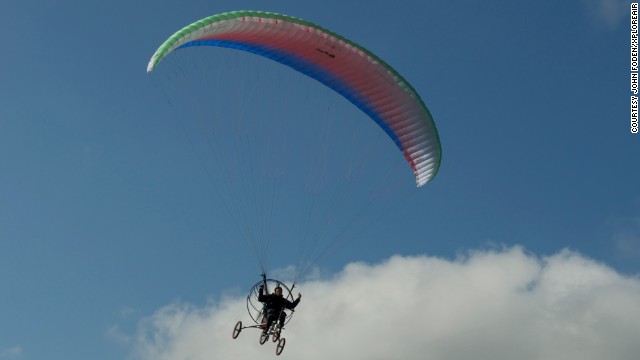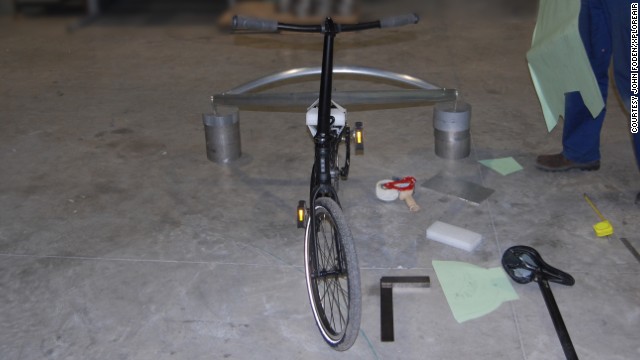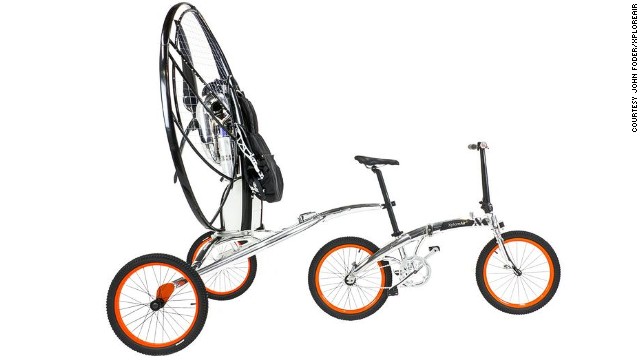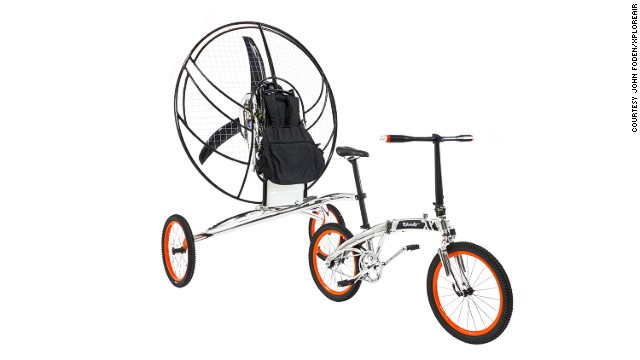British inventors claim world's first flying bicycle
STORY HIGHLIGHTS
- British inventors have built a two-wheeled bicycle that quickly transforms into an aircraft
- The Paravelo flying bicycle can fly to an altitude 4,000 feet at 25mph
- The bike can be be taken on public transport and stored in a garage or flat
(CNN) -- Do you remember that scene in "E.T." where the kids fly away on their BMXs? After seeing it, did you too want to pedal your bike down the street, over your house and past the moon?
Well, now that fantasy can be reality with the invention of the Paravelo flying bicycle.
A pair of flight enthusiasts, John Foden, 37, and Yannick Read, 42, have devised a two-wheeled bike -- christened the XploreAir Paravelo -- that transforms into an aircraft. The British inventors say it is the world's first fully functional flying bicycle.

The machine can travel at speeds of up to 15 miles per hour on the road and 25 miles per hour in the air, reaching altitudes of up to 4,000 feet.
"The Wright brothers were former bicycle mechanics so there's a real connection between cycling and the birth of powered flight that is recaptured in the spirit of the Paravelo," says so-creator John Foden.
We spent our childhoods riding bikes and dreaming of flightJohn Foden, Paravelo co-inventor
The flying bicycle looks like a conventional bike connected to a lightweight trailer, which houses a giant fan, fuel for the contraption's engine and the flexible fold-away wing. Both the airframe and bike are made from aircraft grade aluminum.

The bicycle can be disconnected from its trailer for inner city use, then docks to form a 'para-trike' for take-off. In order to fly, the bike and trailer are fastened together, the wing is unfurled and an electric starter fires the biofuel-powered 249cc motor. Tired Tour de France competitors might want to consider this option before taking on a particularly daunting hill climb.
The Paravelo needs a long stretch of open ground, clear of obstructions for takeoff. Once airborne, it can stay in the air for up to three hours. Once it's in the air, the flying bicycle's inventors say that it controls like a conventional fan-powered paraglider.
The fan can also be detached entirely from its housing and strapped directly onto your back. Worn like this, no license is required to fly it in many countries -- including the U.S. and the UK -- but the United States Powered Paragliding Association strenuously recommends proper training.

So unless you have done it before, jumping off the closest cliff in your new Paravelo is not recommended.
The bicycle is small enough to be taken on public transport, and the entire vehicle can be stowed in a garage or carried up stairs and stored at home.

For generations the car has been king, but it could now play second fiddle to the flying bicycleAndrew Davis, Director of the Environmental Transport Association
Foden says that since childhood he and Read had always wanted to construct a flying bicycle.

"We live in Kingston-upon-Thames, on the outskirts of London, two minutes' walk from the birthplace of the Sopwith Aviation Company -- a British aircraft company that built aircraft including the Sopwith Camel for the Royal Air Force in World War I," he said. "We spent our childhoods riding bikes and dreaming of flight."

Foden and Read hope that at $16,000 the Paravelo will appeal to inner-city flight hobbyists, and believe that it may also be be useful as a "cost-effective aerial reconnaissance vehicle for forest rangers and border patrols."
The flying bicycle's inventors are now looking for support throughKickstarter and have so far raised approximately a tenth of their $78,000 goal. A film of the Paravelo in action can be seen on YouTube.


No comments:
Post a Comment